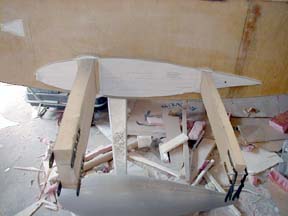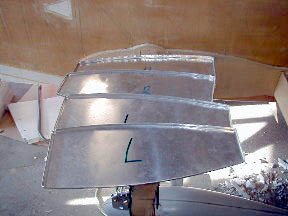|
Fuel Tanks
|
|
Page
1
|
|
|
I am still debating whether
to make aluminum or foam and fiberglass fuel tanks. I will keep you posted
on my decision.
OK, I have decided on aluminum
fuel tanks in the stub wings and for the header tank. Now, to locate a
local supplier for some 5052-H32 aluminum. With the landing gear bracket
out of the stubwing area there is more room for the fuel tanks.
|
|

|
|
|
|
|
I purchased a 2' x4' piece
of high density polyethylene to use as a forming plug. I printed out the
AS5048 airfoil with a 1/2" inside border. I glued the print out onto
the HDPE and cut it out with the band saw. I sanded it to final shape
with a 6" x 48" stationary belt sander. I sheared the 5052 aluminum
to rough size, finished with aviation shears. I clamped the aluminum on
to the HDPE form and used a body work hammer to form the lip to the airfoil
shape. Be sure to make two rights and two lefts
and mark them.
|
|

|
|
|
|
My stub wings are 26"
long so I had two 5' x 24" sheets cut. These sheets will
wrap around the perimeter of the end caps. The perimeter of the finished
end caps were measured and marked on the sheets to bend them to the rough
shape of the airfoil. Three 3" strips were bent into a "V"
shape with flanges. This will be welded to the top inside of the tanks.
The V's are to provide structural support for the wing walks.
|
|

|
|
|
|
Everything will be held in
place with clecos and taken to the welder. The clecos will be removed
after the tanks are tacked together. The heli-arc welder will weld the
holes shut as he welds the tanks together. The filler, sump, vent, drain
and fuel sender plates are drawn in CAD and then produced. They will be
welded to the tanks at the same time.
|
| |
|
|
|
|
|